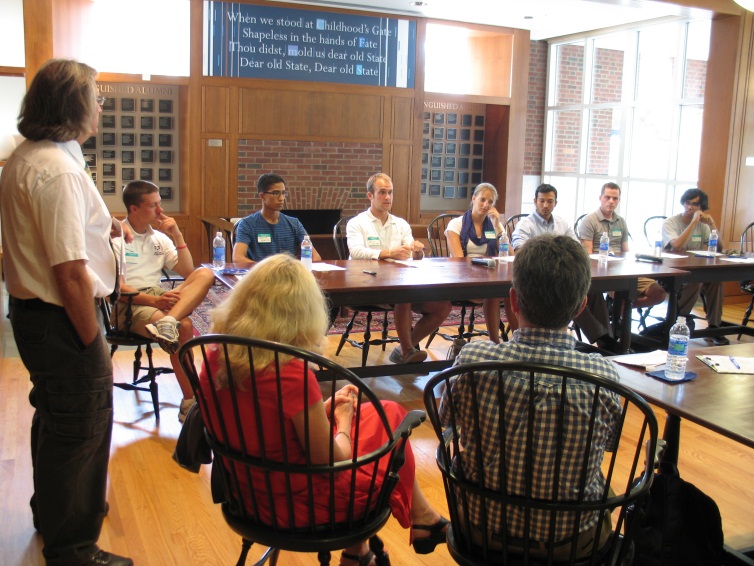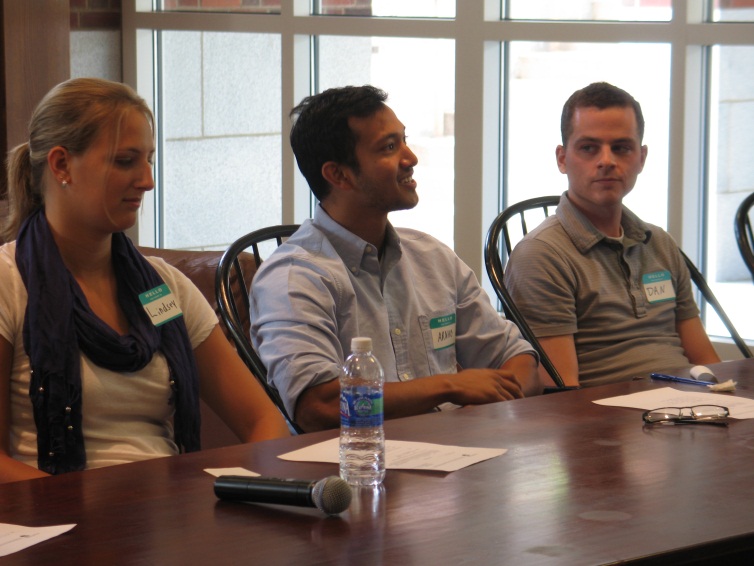We started this school year off by co-hosting, along with the Alumni Center, a student panel for Penn State new faculty. Hearing student voices and their sometimes opposing viewpoints certainly helped each of us in the room to think a bit differently about our students and their perspectives. Dr. Mark Maughmer, an aerospace engineering professor who is one of this year’s Alumni Teaching Award winners, moderated the panel of seven undergraduates and one graduate student. The event, slated for an hour, ran a bit longer because, once the students started, it turned out they had plenty to say!
 To set the stage, Dr. Maughmer asked about the students’ use of technology. Hearing they send and receive some 200 daily text messages brings home a point – technology is a constant in their lives. When asked if we (faculty) should be worried about all of this technology usage, one student’s reply aptly sums up their feelings, “Are you open to communicating with us? Will you use today’s media?” They expect not only to communicate via technology, but they expect current technologies in their learning. As pointed out by one student, “The worst way a professor can use technology is to NOT use technology.” They want their syllabus and other materials electronically available. While ANGEL got mixed reviews from these students, most still expect it to be an integral part of their classes. A real benefit to ANGEL is that they feel it “helps us to operate efficiently.” And being efficient is an underlying operating premise for these students. Although when they brought up that ANGEL is down every day from 4:00 to 6:00 am, you wonder how efficient they can be if they are up at these hours! They also anticipate mediated materials will not just be given to them by a professor, but instead suggest integrating technology into instruction. Developing rich resources is only one part of the equation as explained by one student, “if you are going to use technology, make sure you come with it rather than on it.”
To set the stage, Dr. Maughmer asked about the students’ use of technology. Hearing they send and receive some 200 daily text messages brings home a point – technology is a constant in their lives. When asked if we (faculty) should be worried about all of this technology usage, one student’s reply aptly sums up their feelings, “Are you open to communicating with us? Will you use today’s media?” They expect not only to communicate via technology, but they expect current technologies in their learning. As pointed out by one student, “The worst way a professor can use technology is to NOT use technology.” They want their syllabus and other materials electronically available. While ANGEL got mixed reviews from these students, most still expect it to be an integral part of their classes. A real benefit to ANGEL is that they feel it “helps us to operate efficiently.” And being efficient is an underlying operating premise for these students. Although when they brought up that ANGEL is down every day from 4:00 to 6:00 am, you wonder how efficient they can be if they are up at these hours! They also anticipate mediated materials will not just be given to them by a professor, but instead suggest integrating technology into instruction. Developing rich resources is only one part of the equation as explained by one student, “if you are going to use technology, make sure you come with it rather than on it.”
When asked to explain how they know a class will be good, their answers didn’t contain any surprises. Yet these answers brought home, once again, important things to remember. Be passionate, for it is contagious. Show your students why you are interested in the course material and why it is important for them to know it. Be organized and make sure your syllabus reflects this and provides specifics. Use language that is appropriate for undergraduate students – they made it clear that they recognize you are smart. You don’t need to tell them that. What they need from you is empathy and the ability to help them learn. Provide ways for students to make connections and see the relevancy of this content, otherwise they think it is just “mumble jumble.” Make learning active. As one student noted, “I loved going to his class. The topic wasn’t really my thing, but I had to take the class. The professor taught what he needed to teach in ways that helped me remember. It wasn’t just how he went over the material, for we did activities that helped to illustrate principles.”
 PowerPoint was almost a sore subject. Comments like “a bunch of slides will make a student pass out” and “sometimes I can’t help it, but I fall asleep with PowerPoint” made us think. Dr. Maughmer asked, “Is it PowerPoint or is it PowerPoint used badly that causes you such angst?” The trouble is that far too often the students find it misused. One student added, “A lot of students don’t fall asleep on purpose. There has to be some kind of effort made to keep us engaged.” They all pretty much confirmed that if the professor is just there reading the slides, the students have checked out.
PowerPoint was almost a sore subject. Comments like “a bunch of slides will make a student pass out” and “sometimes I can’t help it, but I fall asleep with PowerPoint” made us think. Dr. Maughmer asked, “Is it PowerPoint or is it PowerPoint used badly that causes you such angst?” The trouble is that far too often the students find it misused. One student added, “A lot of students don’t fall asleep on purpose. There has to be some kind of effort made to keep us engaged.” They all pretty much confirmed that if the professor is just there reading the slides, the students have checked out.
Another issue that distracts students is lack of communication from their professors. Not all that is taught comes easily to the students and they need help when the material is tough. Several suggested that it helps when an instructor acknowledges that the material is tedious and one succinctly remarked “don’t pretend it is the best and instead be candid when it is dry.” Another student added faculty should try to be honest by saying “we are going to go through this with as little pain as possible. You need to learn this.” Dr. Maughner remarked that “brain biology results in our minds needing a little rest every 10 or 15 minutes.” He peppers his students with distractors when he feels he is beginning to lose their attention. If you wonder what happens when a grasshopper goes into the bar, stop by one of his classes. His intention, to help the students reflect and think about what they have just learned before they move on, seems to work since it gives students a bit of a mental break before they have to continue with the complex processing. And a little laughter seems to help keep students engaged.
One dilemma discussed was the role of the professor and the textbook. One of the panelists vehemently wants professors to structure the class just like the textbook. This student only goes to class if it is mandatory because he finds “I am one of those who doesn’t go to class. I read the textbook and that works for me.” He claims that as a self-motivator, he doesn’t need a professor to help convey the textbook and that his approach is efficient. Ironically the student sitting next to him had taken a class with him where both of them had made A’s, yet this student always went to class and never reads the textbook. For him, it is the professor who will make or break a course. Their pronounced preferences helped us to think about the differences in our students and recognize that one size doesn’t fit all.
The graduate student who has been teaching gave us a closing call to action. She stressed “the more demanding you are, the better your students will perform. If you expect excellence of your students, they will perform with excellence. You have to do this from the beginning by making this clear on your syllabus and continuing the whole way through. These undergraduates are capable of so much.” And Dr. Maughmer concluded “they are capable of so little if you don’t.”


 PowerPoint was almost a sore subject. Comments like “a bunch of slides will make a student pass out” and “sometimes I can’t help it, but I fall asleep with PowerPoint” made us think. Dr. Maughmer asked, “Is it PowerPoint or is it PowerPoint used badly that causes you such angst?” The trouble is that far too often the students find it misused. One student added, “A lot of students don’t fall asleep on purpose. There has to be some kind of effort made to keep us engaged.” They all pretty much confirmed that if the professor is just there reading the slides, the students have checked out.
PowerPoint was almost a sore subject. Comments like “a bunch of slides will make a student pass out” and “sometimes I can’t help it, but I fall asleep with PowerPoint” made us think. Dr. Maughmer asked, “Is it PowerPoint or is it PowerPoint used badly that causes you such angst?” The trouble is that far too often the students find it misused. One student added, “A lot of students don’t fall asleep on purpose. There has to be some kind of effort made to keep us engaged.” They all pretty much confirmed that if the professor is just there reading the slides, the students have checked out.